Powering the R3 is a 320cc parallel twin with a "standard," 180-degree crankshaft (no oddball firing order like the FZ-07 or YZF-R1). Yamaha has not released a claim for horsepower, but suggested confidence when claiming, "most in class." (We think that probably doesn't include KTM's RC390.) We will run one on the dyno as soon as we can, but expect slightly more grunt than Kawasaki's Ninja 300—probably around 24cc worth.
The seat is low, at 30.7 inches (the same height as Honda's CBR300R, and 0.2 inches lower than the Ninja 300), and is quite flat front-to-back and narrow at the front. At 368 pounds with gas (claimed), the R3 is about 10 pounds lighter than the Ninja 300. True, it's also 10 pounds heavier than a CBR300, but this is a seriously approachable machine. All but the most diminutive riders will be feeling confident at stoplights.
Well-calibrated fuel injection and a short first gear mean leaving stoplights is easy, too. We idled around a parking lot in first gear with the speedo showing 4 mph. The gearbox uses fairly close ratios, which adds up to sixth gear being useable for anything over 40-45 mph. Motorcyclists with confident clutch feel and highway miles in their future will probably want to gear the R3 up a little, but even with stock gearing the motor is smooth and unstressed up to freeway speeds.
Brakes are single discs front and rear, as expected for the class. Initial bite from the two-piston Akebono caliper up front is a little soft, but with a little extra squeeze there’s plenty of power to slow down. Carefully, though; there is no ABS. Without having compared directly, the R3’s brakes remind us of the Ninja 300’s; good but not as good as Honda CBR300’s, which combine good feel with much more assertive bite.
Suspension, too, is definitely in the ballpark with its Japanese competitors. The fork is a 41mm KYB unit (4mm larger than the Honda or Kawasaki’s, but 2mm smaller than the KTM’s), and shares good compliance with the KYB shock holding up the rear. The shock is adjustable for seven levels of preload, and at 185 pounds this editor was glad to be able to dial in more spring. The suspension is definitely on the soft side, but soaked up bumps all morning during our 120-mile street ride while feeling perfectly stable. All in all, completely satisfactory in the class.
As we’ve seen with Yamaha’s other bargain bikes (think FZ series), low cost doesn’t mean all of the niceties are left out. The R3 is outfitted generously, with an LED taillight, properly knurled footpegs, and crisp paint that looks as good up close as it does rolling past. Especially well appointed is the dash unit, which uses the correct combination of analog tachometer and digital speedo, as well as including a fuel gauge, shift light, and instant/average fuel economy figures. Picking nits, we always think it’s annoying when a bike has a fuel gauge and offers mileage figures but doesn’t calculate range—come on, all of the data is there!
The R3 is an all-new bike for the US market, but shares most of its parts with the R25, a 250cc sportbike that Yamaha has been selling in the global market. As a result, the fit and finish of the R3 is above the status quo for a first-generation model. It’s built in Indonesia, but has none of the quirks or rattles a skeptical consumer might expect. In fact, the first thing you will notice about the R3 is the attention to style—we think the nicely shaped, cast swingarm is a great touch. The bike fits together well and has a definite parking-lot presence.
Which leads us to the best news of all: price. Just as the suspension, brakes, and seat height all fit in line with the competition, so too does the $4,990 base price. That’s nine bucks cheaper than a similarly equipped Ninja 300, and around $600 more than a CBR300 ($4,399 without ABS). Both the Ninja and CBR have ABS as an option, which we have long stood by as an excellent feature in a motorcycle designed for less experienced riders, and, ever the wildcard, KTM’s RC390 comes with ABS standard for $5,499. Even without an ABS option, the R3 is a worthy competitor.
More to the point, all of motorcycling should rejoice that Yamaha has joined this area of the market with such a capable, stylish, and fun motorcycle. While we can’t wait for our comparison test with all of the other bikes in the category (think Honda, Kawasaki, and KTM), you can tell your friends that Yamaha’s new R3 is here, and it’s good.










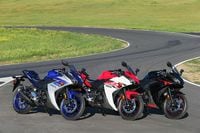

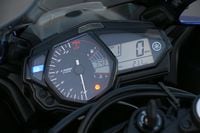

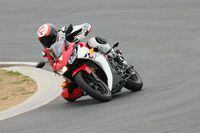
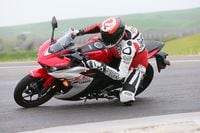

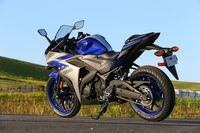
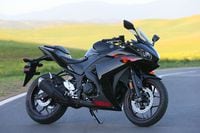
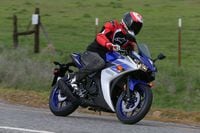
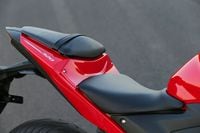


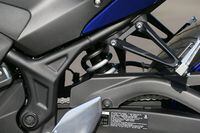

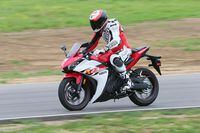
/cloudfront-us-east-1.images.arcpublishing.com/octane/MUQLOVLL2ZDGFH25ILABNBXKTI.jpg)
/cloudfront-us-east-1.images.arcpublishing.com/octane/TNOU5DNE2BC57MFPMGN2EIDXAM.jpg)
/cloudfront-us-east-1.images.arcpublishing.com/octane/GTCXACQGJ5HAPDTGWUQKDEH44E.jpg)
/cloudfront-us-east-1.images.arcpublishing.com/octane/S35YGSEMEZB4BLTDJTSZPF4GLA.jpg)
/cloudfront-us-east-1.images.arcpublishing.com/octane/5UOT6HPX2JFMRJAX6EH45AR4MQ.jpg)
/cloudfront-us-east-1.images.arcpublishing.com/octane/OKWOJWAKP5EP3OACCRRWPCIX2Q.jpg)
/cloudfront-us-east-1.images.arcpublishing.com/octane/2WF3SCE3NFBQXLDNJM7KMXA45E.jpg)
/cloudfront-us-east-1.images.arcpublishing.com/octane/G4MG6OUCJNBSHIS2MVVOTPX65E.jpg)
/cloudfront-us-east-1.images.arcpublishing.com/octane/IIGGWFOTOJGB7DB6DGBXCCMTDY.jpg)
/cloudfront-us-east-1.images.arcpublishing.com/octane/QSTCM6AVEZA5JJBUXNIQ3DSOF4.jpg)
/cloudfront-us-east-1.images.arcpublishing.com/octane/U4I7G625B5DMLF2DVIJDFZVV6M.jpg)
/cloudfront-us-east-1.images.arcpublishing.com/octane/B6XD6LS6IVCQPIU6HXDJSM3FHY.jpg)
/cloudfront-us-east-1.images.arcpublishing.com/octane/ICL63FEDDRDTTMINYICCEYGMDA.jpg)
/cloudfront-us-east-1.images.arcpublishing.com/octane/FCGZHQXRBZFLBAPC5SDIQLVF4I.jpg)
/cloudfront-us-east-1.images.arcpublishing.com/octane/WNOB6LDOIFFHJKPSVIWDYUGOPM.jpg)

/cloudfront-us-east-1.images.arcpublishing.com/octane/X33NU3E525ECRHXLNUJN2FTRKI.jpg)
/cloudfront-us-east-1.images.arcpublishing.com/octane/6KKT5NNL2JAVBOXMZYS5ZO76YA.jpg)
/cloudfront-us-east-1.images.arcpublishing.com/octane/J5RKG5O455GMPGQRF2OG6LRT7A.jpg)
/cloudfront-us-east-1.images.arcpublishing.com/octane/GX2CIZKQVRH2TATDM26KFG2DAE.jpg)
/cloudfront-us-east-1.images.arcpublishing.com/octane/ZWIDYSAKQZHD5BHREMQILXJCGM.jpg)
/cloudfront-us-east-1.images.arcpublishing.com/octane/CYUHJZCTSJCH3MRAQEIKXK7SCQ.jpg)
/cloudfront-us-east-1.images.arcpublishing.com/octane/LKOFINY56FCXJCANJ5M7ZDQUBY.jpg)
/cloudfront-us-east-1.images.arcpublishing.com/octane/4NBPDACMWJH63JQYJVK3QRBDZI.jpg)